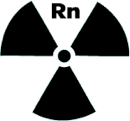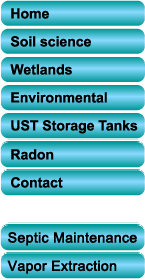Vapor Extraction
Professional Geologists & Soil Scientists Providing Environmental Consulting Services

VAPOR EXTRACTION
Vapor intrusion is defined as the migration of volatile contaminants from the subsurface into overlying buildings. Radon Controls provides mitigation of vapor intrusion to prevent human exposure to soil and groundwater contaminants. The mitigation employs a ventilation technique whereby soil gas migration is influenced by a combination of depressurization, dilution and soil vapor extraction.
The majority of vapor intrusion cases occur when contaminants from either soil or groundwater enter the soil gas at the water table or in the unsaturated zone. The contaminated soil gas then migrates under the influences of advective flow or diffusion until they escape to the atmosphere or enter the zone of influence of a building. When the pressure in the lowest portion of the building is lower than the pressure in the soil below the building soil gas advectively flows or diffuses into the building.
Depressurization is a technology that is used to reduce vapor intrusion by implementing a design to achieve lower air pressure under a floor slab than above it to change flow direction that is driven by pressure or density differences. Installation of a sub-slab ventilation system that induces a negative pressure gradient across the foundation causes soil depressurization. Depressurization reverses the pressure gradient that that drives the advective flow or diffusion of soil gas, thus reducing entry into the building.
Dilution is a technology that is used to reduce vapor intrusion by diminishing the concentration of volatile organic compounds by admixture when the surrounding soil has a relatively high permeability. Installation of a sub-slab ventilation system can pull large quantities of air through the soil diluting the contaminant in the sub-slab region reducing entry into the building.
Soil vapor extraction (SVE) is a technology that is used to remove volatile organic compounds from any porous material such as the ground or engineered fill material that underlies a building by evaporation and evacuation. Installation of a sub-slab ventilation system volatilizes and removes the contaminant reducing entry into the building.
Soil vapor extraction also serves to promote long term rehabilitation by diminishing the quantity of the contaminant. Soil vapor extraction takes advantage of the characteristic of volatility of the contaminant. Volatile organic compounds (VOCs) in soil will evaporate readily until the vapor pressure reaches equilibrium in the soil gas. The vapors fill the spaces between the grains of the soil, and can migrate through the soil along with the soil gases that are normally there. If left in place long enough, any volatile contaminant in soil will evaporate just like an open container of water. However, due to the slow rate of natural soil gas movement, the process will typically take years to decades. SVE takes advantage of this evaporation and mobility by directing it and speeding it up. Dry wells are bored into the contaminated soil. Blowers are used to pull air out of the wells, establishing a pressure gradient, so that the soil gas around the well will migrate towards it. The continuous evacuation of soil gas from the dry wells prevents contaminant vapor pressures from reaching equilibrium. Since the contaminant is no longer in equilibrium with the soil gas, more evaporates. The evaporation continues until contaminant concentrations in the soil gas reach asymptotic conditions.
Radon Controls is an operating division of GeoEnvironmental Services, Inc. (GESI) that has installed more than 15,000 vapor extraction systems in various building types including, commercial, residential, multi-unit housing, schools and strip shopping centers. We have installed vapor extraction systems in multiple dry cleaning facilities to provide mitigation for volatile organic compound contamination. The Principal of our Company, Larry James Giannasi, is a Virginia Certified Professional Geologist and a Virginia Certified Professional Soil Scientist. Mr. Giannasi has over 27 years of experience in the design and installation of SVE systems.

Radon Controls
A Division of GeoEnvironmental Services, Inc.









